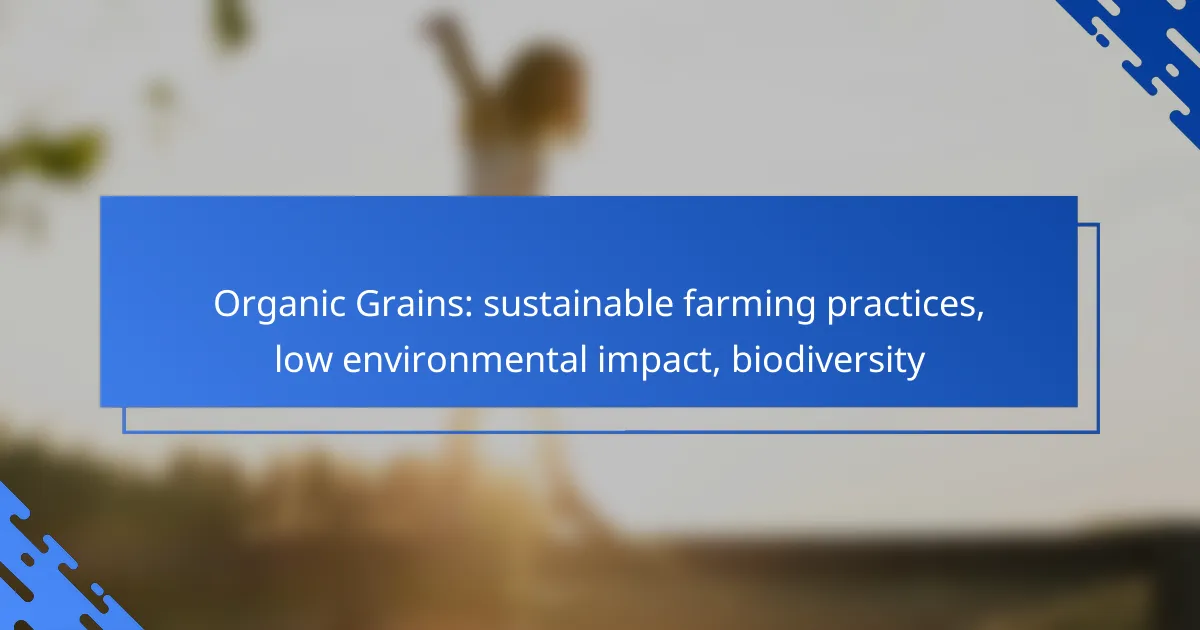Organic superfoods are vital in promoting regenerative agriculture, as they enhance soil health and support biodiversity while fostering ecosystem resilience. By prioritizing sustainable practices, these superfoods not only improve food quality but also contribute to a low carbon footprint and reduced environmental impact.

How do organic superfoods support regenerative agriculture?
Organic superfoods play a crucial role in supporting regenerative agriculture by enhancing soil health, promoting biodiversity, and fostering ecosystem resilience. These practices not only improve the quality of the food produced but also contribute to a sustainable agricultural system that minimizes environmental impact.
Improves soil health
Organic superfoods contribute to soil health by using natural farming techniques that enhance soil structure and nutrient content. Practices such as crop rotation, cover cropping, and composting help maintain soil fertility and prevent erosion.
For example, incorporating legumes into crop rotations can naturally fix nitrogen in the soil, reducing the need for synthetic fertilizers. This not only improves soil quality but also supports healthier plant growth.
Enhances ecosystem resilience
By promoting diverse farming practices, organic superfoods enhance ecosystem resilience against pests and diseases. A varied crop system can disrupt pest cycles and reduce the reliance on chemical pesticides.
Additionally, regenerative agriculture practices like agroforestry can create microclimates that protect crops from extreme weather, thereby increasing the overall stability of the agricultural ecosystem.
Promotes biodiversity
Organic superfoods encourage biodiversity by supporting a wide range of plant and animal species on farms. This diversity is essential for maintaining ecological balance and ensuring the sustainability of agricultural practices.
Farmers can promote biodiversity by planting a variety of crops and using organic methods that attract beneficial insects, such as pollinators. This not only enhances crop yields but also contributes to a healthier environment.

What are the environmental benefits of organic superfoods?
Organic superfoods offer significant environmental benefits, including a low carbon footprint, reduced chemical runoff, and conservation of water resources. These advantages stem from practices associated with organic farming, which prioritize sustainability and ecological balance.
Low carbon footprint
Organic superfoods typically have a lower carbon footprint compared to conventionally grown foods. This is largely due to the absence of synthetic fertilizers and pesticides, which require energy-intensive production processes. Additionally, organic farming practices often focus on soil health and biodiversity, which can enhance carbon sequestration in the soil.
For example, regenerative agriculture techniques, such as crop rotation and cover cropping, can significantly reduce greenhouse gas emissions. Choosing organic superfoods can therefore contribute to lower overall emissions in the food supply chain.
Reduces chemical runoff
Organic superfoods help minimize chemical runoff into waterways, which is a common issue with conventional agriculture. The use of synthetic fertilizers and pesticides can lead to nutrient pollution, harming aquatic ecosystems and drinking water sources. Organic farming avoids these chemicals, relying instead on natural alternatives that do not leach into the environment.
Practices such as composting and natural pest management not only protect water quality but also promote healthier soil. This results in a more sustainable agricultural system that supports biodiversity and ecosystem health.
Conserves water resources
Organic farming methods are generally more efficient in water usage, contributing to the conservation of this vital resource. Techniques like mulching, crop rotation, and organic matter addition improve soil structure and moisture retention, reducing the need for irrigation.
In regions where water scarcity is a concern, choosing organic superfoods can help alleviate pressure on local water supplies. By supporting organic practices, consumers can play a role in promoting sustainable water management in agriculture.

Which organic superfoods are best for biodiversity support?
Organic superfoods that support biodiversity include quinoa, chia seeds, and spirulina. These foods not only provide nutritional benefits but also contribute to sustainable agricultural practices that enhance ecosystem health.
Quinoa
Quinoa is a highly nutritious grain that thrives in diverse climates, making it a resilient crop. Its cultivation can enhance soil health and support local biodiversity by providing habitats for various species. Additionally, quinoa is often grown using organic methods that avoid harmful pesticides and fertilizers.
When sourcing quinoa, look for varieties that are certified organic and sourced from regenerative farms. This ensures that the farming practices promote biodiversity and soil health, which are crucial for sustainable agriculture.
Chia seeds
Chia seeds are not only rich in omega-3 fatty acids but also contribute positively to biodiversity. They are often grown in rotation with other crops, which helps to maintain soil fertility and reduce pest populations naturally. This crop can adapt to various environments, supporting agricultural diversity.
To maximize the biodiversity benefits of chia seeds, choose products that are certified organic and sourced from farms that practice sustainable agriculture. This supports ecosystems and encourages the use of natural farming techniques.
Spirulina
Spirulina is a blue-green algae that is cultivated in freshwater environments, often in controlled settings that minimize environmental impact. Its production can be highly efficient, requiring less land and water compared to traditional crops, which helps preserve natural habitats.
When purchasing spirulina, opt for brands that prioritize sustainable harvesting and organic certification. This ensures that the spirulina you consume supports biodiversity and is produced with minimal ecological footprint.

How can consumers identify high-quality organic superfoods?
Consumers can identify high-quality organic superfoods by looking for specific certifications, ensuring sourcing transparency, and evaluating nutrient profiles. These factors help guarantee that the products are genuinely organic and beneficial for health and the environment.
Look for certifications
Certifications are essential indicators of quality in organic superfoods. Look for labels such as USDA Organic, EU Organic, or similar certifications that meet strict agricultural standards. These certifications ensure that the products are grown without synthetic pesticides, fertilizers, or genetically modified organisms.
Additionally, certifications like Fair Trade or Non-GMO Project Verified can provide further assurance about ethical sourcing and production practices. Always check the packaging for these labels to confirm the product’s authenticity.
Check for sourcing transparency
Sourcing transparency is crucial for understanding where and how organic superfoods are produced. Brands that provide detailed information about their sourcing practices often demonstrate a commitment to quality and sustainability. Look for brands that disclose the origin of their ingredients, including the specific farms or regions.
Some companies may even share information about their farming practices, such as regenerative agriculture methods that enhance biodiversity and reduce carbon footprints. This transparency allows consumers to make informed choices about the environmental impact of their purchases.
Evaluate nutrient profiles
Evaluating the nutrient profiles of organic superfoods helps consumers understand their health benefits. Check the product labels for key nutrients, such as vitamins, minerals, and antioxidants. High-quality superfoods typically have a rich nutrient density, meaning they provide a significant amount of nutrients relative to their calorie content.
Consider comparing the nutrient profiles of different brands or products. A simple way to do this is by looking for superfoods that offer a wide range of vitamins and minerals, such as spirulina, chia seeds, or acai berries. This ensures that you are choosing products that contribute positively to your overall diet.

What are the economic impacts of supporting organic superfoods?
Supporting organic superfoods can significantly boost local economies while promoting sustainable agricultural practices. By investing in organic farming, communities can enhance their economic stability and environmental health.
Boosts local economies
Organic superfoods often require local sourcing and labor, which directly benefits nearby farmers and workers. This can lead to increased job opportunities and higher income levels within the community.
Furthermore, consumers are increasingly willing to pay a premium for organic products, which can result in higher profit margins for local producers. This economic uplift can foster community development and infrastructure improvements.
Encourages sustainable farming practices
Supporting organic superfoods promotes regenerative agriculture, which focuses on enhancing soil health and biodiversity. This approach can lead to improved crop yields over time and reduced reliance on chemical fertilizers and pesticides.
Farmers adopting these practices often see long-term benefits, including lower input costs and increased resilience against climate change. By prioritizing sustainability, they contribute to a healthier ecosystem, which can further attract eco-conscious consumers.

How do organic superfoods compare to conventional options?
Organic superfoods generally offer superior health benefits compared to conventional options, primarily due to their cultivation methods. They are grown without synthetic pesticides or fertilizers, which enhances their nutrient profiles and supports environmental sustainability.
Higher nutrient density
Organic superfoods typically have a higher nutrient density than their conventional counterparts. This means they contain more vitamins, minerals, and antioxidants per serving, which can contribute to better overall health. For instance, organic fruits and vegetables often show increased levels of vitamin C and polyphenols.
The nutrient density in organic produce is attributed to healthier soil management practices, such as crop rotation and composting, which promote biodiversity. These practices not only enhance the nutritional quality of the food but also support the ecosystem by fostering a variety of plant and animal life.
When selecting organic superfoods, look for labels that indicate they meet established organic standards, such as USDA Organic in the United States or EU Organic in Europe. This ensures that the products have been grown without harmful chemicals and adhere to sustainable farming practices.










